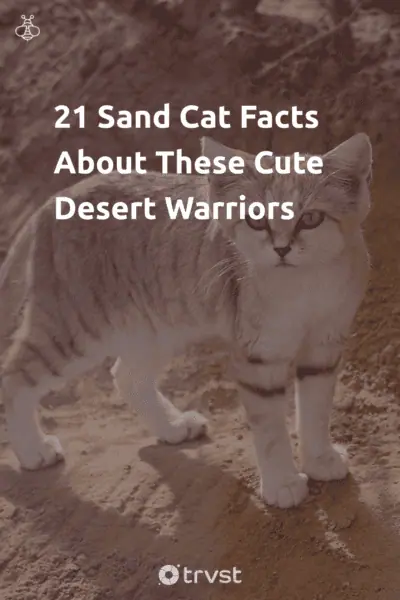21 Sand Cat Facts About These Ferocious Desert Warriors
With their soulful large eyes and small body, sand cats are super adorable creatures. They look like stockier versions of domestic cats, but the similarity ends with their looks. Sand cats are ferocious hunters that live in the hottest places on earth.
You will find this cat species naturally occurring in arid ecosystems with flat or rolling terrains in Africa, the Arabian peninsula, and southwest and central Asia. While other wild cats pass through deserts, the sand cat lives permanently in the waterless areas of the desert.
People rarely see these cats in the wild, and their elusiveness is part of their allure. This article shares 21 facts you would love to know about these super cute desert warriors.
First, meet the sand cat.
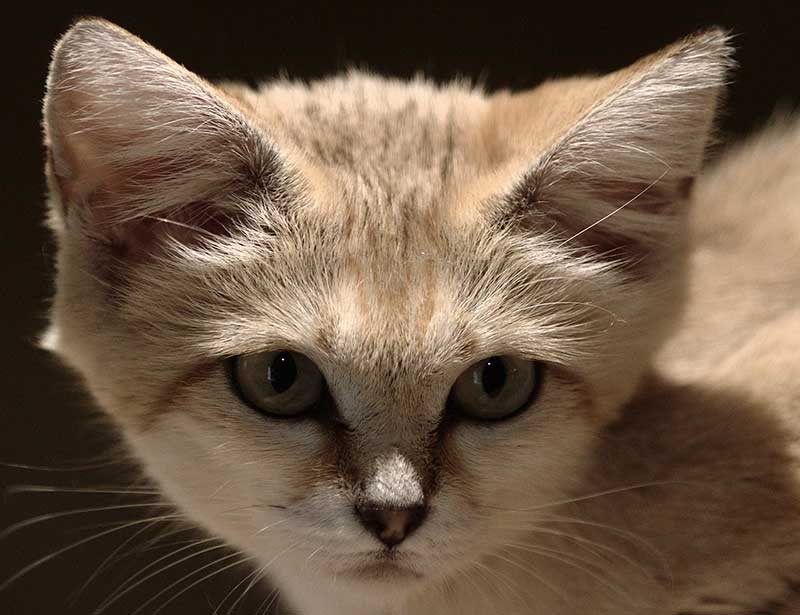
Sand cats (Felis margarita) have a sandy fur coat but can have a dark brown or light grey shade. This wild cat species has slightly darker fur coloring on their backs, with pale fur on the underparts. Some have dark stripes across their backs, others have spots, and some have no markings at all. The markings can be faint on some individuals and more visible in others.
The black or brown bands around their limbs are usually a more visible marking. Their tail has two or three rings of dark fur around it and ends with a black tip.
The sand cat has a relatively broad head framed with a pair of low-set fluffy ears. On their face, two bold red streaks run across the cheeks from the outer corner of each eye. They have short limbs and claws that never fully retract.
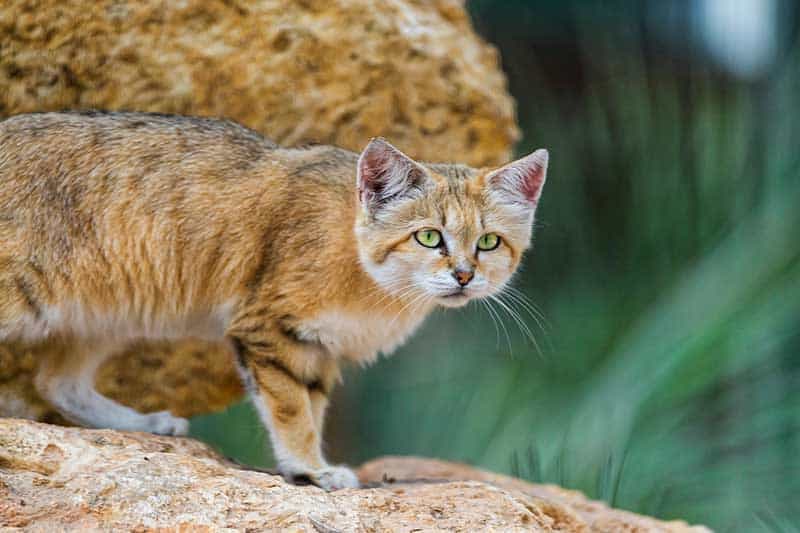
1. Their scientific name reminds you of a cocktail
Another name for the sand cat is the ‘sand dune cat,’ but there is another that’s more interesting. Its scientific name is Felis margarita, and no, they did not name it after that happy-hour alcoholic drink.
Victor Loche, a French soldier and naturalist, first described the creature after encountering it in the Algerian section of the Sahara desert in 1858. He named the cat after the French general, Jean Auguste Margueritte, who led the expedition during which Loche discovered the sand cat4.
2. They exist in just two continents of the world
Asia and Africa are the only continents where sand cats live. They are found in just three distinct areas across both continents. They exist in the Sahara desert in northern Africa, cutting across Morocco, Algeria, and Niger. In southwest Asia, we can find them across the Arabian peninsula, and in central Asia, we find them in Afghanistan, Turkmenistan, Iran, and Pakistan.
The four different subspecies of the sand cat are associated with four distinct areas2. The ‘felis margarita margarita’ is found in North Africa, while the ‘felis margarita harrisoni,’ also called the Arabian Sand Cat, is found in Saudi Arabia. In Turkmenistan, we have the ‘felis margarita thinobia’ while Pakistan has the ‘felis margarita scheffeli.’
3. They have adapted to survive in the desert
Not many living things can survive in the desert, but the sand cat thrives in the harsh desert environment. They have various habits and adaptations that enable them to live in sandy and stony deserts. They start by staying near areas with at least some sparse vegetation where they are more likely to find prey rather than roaming sand dunes.
The long hairs that grow between their toes create a dense layer of fur covering their foot pads. The thick fur protects their paws from burning on the hot sand.
A thick sand-colored fur covers their body, provides excellent camouflage, and provides insulation from extreme weather changes. Desert surface temperatures can go up to 51 degrees C during the day and drop to about -0.5 degrees C at night. Sometimes, they will lie on their backs outside their burrow to let out internal heat.
Meanwhile, in colder climates, the sand cat's winter coat grows thick to protect them from the chilly desert nights.
4. The sand cat is the smallest of all wild cats
Lions, leopards, and tigers are well-known wild cats, but the wild cat family also includes small wild cats like the caracal, Pallas cat, and the sand cat. They don't grow bigger than domestic cats, but there seems to be sexual dimorphism between males and females in terms of weight.
The adult sand cat has a head-body length of 15 to 20 inches and a tail about 9 to 12 inches long. In contrast, the male weighs between 2 to 3.4 kg, while the adult female weighs about 1 to 3 kg.
5. Location affects their breeding season
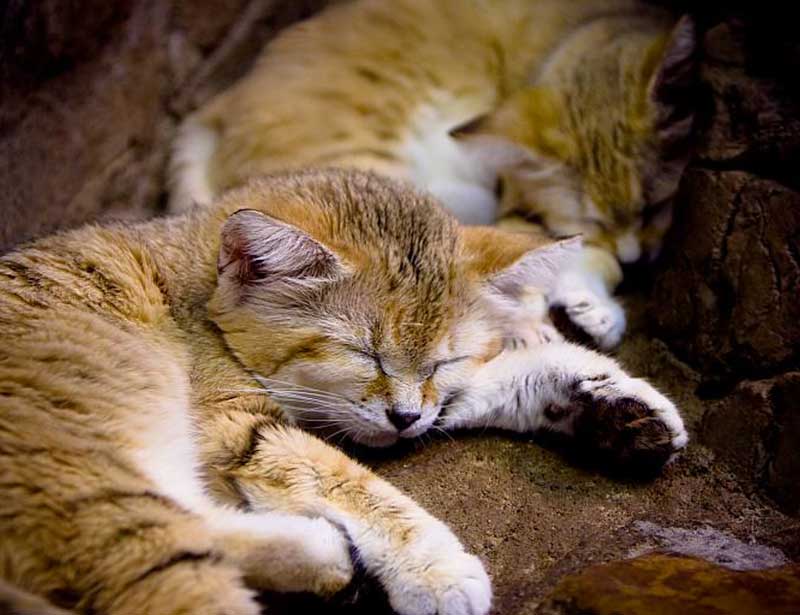
Sand cats breed seasonally, and the breeding season differs from location to location—those in the Sahara breed from January to April, and those in Turkmenistan breed from April. In Pakistan, they breed from September to October.
They typically have about two to three kittens in a litter, each weighing about an ounce, but the number can vary from one to eight. The sand cat has just one litter in a year in the wild, but in captivity, reproduction can occur more than once a year. Scientists have suggested that climate and the availability of adequate resources determine the sand cat’s breeding season.
6. Sand cats are altrical
The gestation period for sand cats is between 59 to 63 days. Young cats are dependent at birth; they can neither see nor walk. They have to depend on their mother for food and protection. After about two weeks, their eyes open, and they can see venturing outside their home after four weeks. At five weeks old, they are ready for solid food.
At 6 to 8 months, they become fully independent and, by 9 to 14 months, become sexually mature. Maturing quickly is an advantage in the sand cat’s hostile environment. They can increase their chances of survival by gaining independence and learning to hunt earlier.
7. The sand cat lives for more than a decade
We may not know if the sand cat has nine lives, but we know it lives a rather long cat life. Sand cats live for up to 16 years in captivity before succumbing to old age and natural death. One problem is that in captivity, they have a high mortality rate. Their biological adaptation to desert survival may work against them in other environments.
Because of their secretive behavior, we don’t know much about this creature’s lifespan in the wild.
8. They are solitary animals
Adult sand cats lead solitary lives. This doesn't mean they can't share their home range with other individuals. Unlike other cats, sand cats are not territorial and won't make a fuss over the presence of other individuals in their environment. They simply do not form groups or hunt or live together. However, a breeding female has to share her space with her kittens before they become independent.
Their solitary lifestyle doesn't affect breeding because they have super sensitive hearing and can hear the bark-like mating calls over great distances1. Other forms of communication include leaving scent marks or claw scratches on objects in their home range. They leave scent marks by rubbing their body against objects or spraying their urine.

9. They have invisibility tricks
Sightings of sand cats are rare because they are hard to track and have certain traits that help them maintain their elusiveness. The dense hair on the soles of their feet stops them from sinking into the soft desert sand enough to leave easily trackable pawprints.
Another trick is burying their feces; It isn't explicitly clear why they do this.
Usually, cats have reflective eyes that give them away from a distance in the dark. When sand cats observe that searchlights are focused on them, they crouch low and close their eyes. They do this to blend into the environment and avoid detection through the glow of their eyes.
10. Sand cats can survive for weeks without water
The sand cat inhabits areas that get less than 20 mm of rainfall all year. However, the unavailability of water doesn't faze them, as they can survive for weeks without a single drop of water. They get the hydration they need from moisture in their prey. They will drink water when it is available, which isn't very often.
11. These cats travel extensively
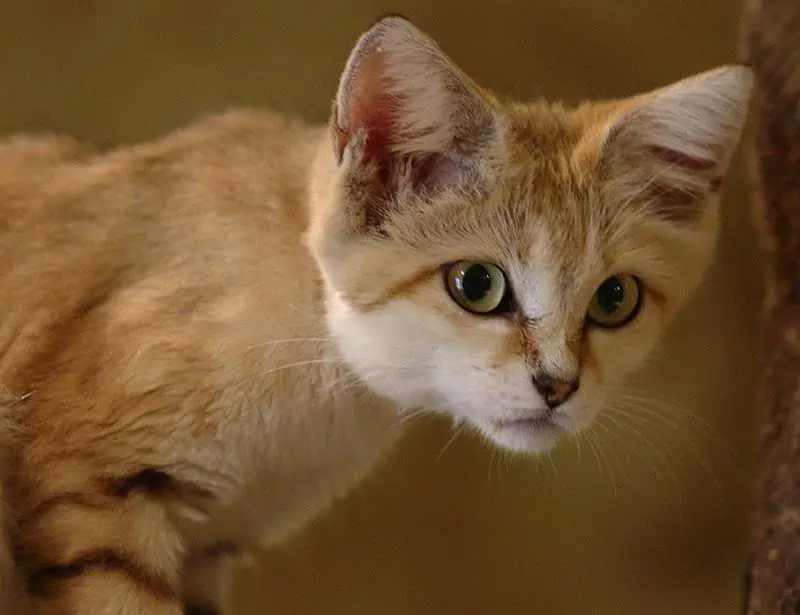
News isn't the only thing that travels fast; the sand cat does, too. They can cover long distances in a relatively short time, about 5 to 10 km in one night. Sand cats are not very good at making great jumps or climbing, but they run pretty fast. They can run at a speed of 40km/h.
Before leaving its den for its nightly hunts, the sand cat stands at its den’s entrance and surveys the environment for a while before leaving. It does the same surveying when it returns at dawn. This survey is probably to watch out for predators and other dangers.
12. They have enhanced hearing
The sand cat’s hearing is one of its most advanced senses. In their environment, hearing is essential for hunting and survival. The ear passage and auditory bulla in the sand cat are larger than in other small wild cats and even big cats. The widened ear canal gives the sand cat its enhanced hearing abilities.
The sand cat has large outer ears that offer some protection against blowing sand getting into the ear. Long hairs growing close together prevent foreign objects from entering the inner ears.
13. They bark
Like the domestic cat, a sand cat can make meowing, hissing, purring, and growling sounds like other small cats. But its vocalization range extends to barking, too. They can produce a high-pitched barking sound like small domestic dogs do.
They use this barking sound more during mating season to signal their location to prospective mates. This barking sound is very loud because they tend to stay as far away from each other as possible. And they need to hear one another over the distance.
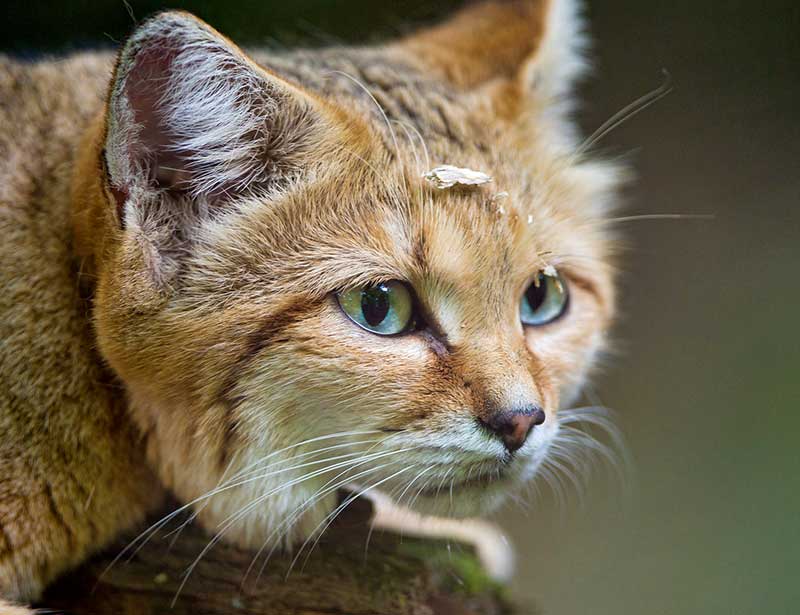
14. They hunt by digging
Like all cats, the sand cat is carnivorous. It feeds on snakes, birds, reptiles, hares, and small rodents. Uniquely, it also includes insects in its diet. Sand cats hunt alone, and only female sand cats share their meal with their young. The sand cat is an opportunistic predator and will kill prey whenever it finds one. They aren't wasteful and will cover opportunistic or large kills with sand, so they return to finish it later.
The sand cat will skulk close to the ground on bent legs to detect prey. Its enhanced ears listen for prey burrowing underneath. Once the sand cat hears a potential meal, it begins to dig the ground rapidly, and the animal is exposed and captured in no time. They kill snakes by delivering rapid blows to their heads, which stuns them long enough to bite their neck to death.
We know they're excellent diggers. But it is impressive that they do so much digging with claws that are not so sharp. There is little opportunity for these prolific diggers to sharpen their claws in the desert.
15. Sand cats are nocturnal animals
The sand cat is more active at night3. No surprise there; the desert can get very hot in the daytime, but the nighttime is cooler, so it does most of its hunting and traveling at night.
What do they do all day? Sand cats spend most of their daylight time resting in a shallow burrow or under the shade of a shrub. They can dig their burrows but sometimes take over small animals' burrows and enlarge them to fit them.
Sand cats don't get possessive over their dens; they enter empty dens and leave freely. Multiple cats will use a den, but not at the same time. Their solitary nature does not allow adults to cohabit.
16. They keep prey populations under control
Rats, mice, and venomous snakes are food for sand cats. The sand dune cat preys upon small rodents and snakes, keeping their population in check. If there were no sand cats, dangerous snakes, rodents, and other pests, they would overrun the desert landscape.
Rodents consume agricultural produce and endanger human life with the diseases they carry. And snakes can hurt desert travelers or people in settlements close by. Some countries derive revenue from desert tourism, which would be badly affected by an unchecked population of desert snakes and rodents.
So sand cats are saving us the time and financial costs of dealing with this problem ourselves.
17. Humans and other animals are predators of the sand cat
The sand cat has many natural enemies, like venomous snakes, wolves, jackals, and, of course, humans. People also kill them for various reasons, including sports. Desert settlers often do so to protect their livestock. Killing sand cats is surprisingly easy for humans because these fearless snake hunters are not aggressive when confronted with a human attacker.
Fortunately, some cultures prohibit hunting a sand cat. The Toubou people of northwest Lake Chad do not hunt sand cats because they believe they were companions of the Prophet Mohammed and his daughter.
18. Human settlements threaten their populations
They have identified the major threats to sand cats as habitat loss and habitat degradation caused by human settlements. Political conflicts with environmental consequences in the Arabian peninsula have caused the sand cat's sand dune habitat to decline. In some countries, the arid habitat is a target of industrial and residential developments.
Human settlement activities, especially livestock grazing and uprooting shrubs, can disrupt the already vulnerable arid ecosystems sand cats inhabit. The presence of feral and domestic dogs and feral cats is also a problem. These issues can cause an increase in drifting sand areas, a decline in prey, and the spread of diseases.
19. They are common victims of unintentional killings
Sometimes, a sand cat walks into a trap laid out for other animals. People who live in desert oases usually lay traps for jackals, foxes, and other predators that attack their livestock. They lay these traps for retaliation and not really to protect the livestock. So they typically set away them from human settlements where a sand cat may walk into them too.
20. They are not great pets
In Algeria and other countries with rare sand cats, poachers capture and sell them as exotic pets. As they don't find it easy to adapt to life outside their desert ecosystem, they are susceptible to several respiratory illnesses outside their natural environment. They also have a high infant mortality rate.
You shouldn't consider keeping one as a pet, as they will most likely die within a few months. Also, their population is likely unstable in the wild; keeping them as exotic pets doesn't help conservation efforts in any way.
21. We don't know how many sand cats are living in the wild
Because of its secretive habits and scattered population, we don't have concrete data on the population of sand cats in the wild. The exact number of sand cats in the world is a mystery. The International Union for Conservation of Nature conservatively estimates the total population at 27,264 mature individuals.
However, we can be fairly sure of the population size that is being raised in zoos globally. There are 51 sand cats in zoos accredited by the Association of Zoos and Aquarium.
Are sand cats endangered?
Although the IUCN red list lists the sand cat currently as ‘least concern,’ it may soon return to being a near-threatened species, as it once was. Reports of sightings are decreasing, which may indicate a decreasing sand cat population.
The population in some regions is seriously endangered. The Regional Red List of the United Arab Emirates classifies the cat as endangered. Wild sand cats have gone extinct in Israel.
Like many other endangered species, human encroachment on their desert habitat threatens their life in the wild. Additionally, disease transmission from domesticated cats and dogs is thought to be a problem.
Conservation efforts
As part of conservation efforts, they have reared sand cats in captivity. In 2010, the AL Ain Zoo announced the birth of two sand cat kittens. Two years later, the European endangered species program successfully aided the birth of four sand cat kittens at the Ramat Gan Zoo.
Many more kittens have been born in captivity since then. Most recently, in May 2022, 5 kittens were born in the Ramat Gan Zoo. The sand cat is in Appendix II of CITES. Poaching and sport hunting sand cats are prohibited in Israel, Iran, Pakistan, Kazakhstan, and the United Arab Emirates.
Conclusion
The sand cat is the cutest wild cat that isn't afraid of the hot sands of the desert or its sparse vegetation. It is super mysterious and has given researchers so much trouble trying to collect data about it. But there is a high probability that these endangered cats are a near-threatened species.
Main Photo Ranjith-chemmad (CC BY-SA 4.0)
| 1 | Huang, .G., Rosowski, .J., Ravicz, .M. et al. Mammalian ear specializations in arid habitats: structural and functional evidence from sand cat (Felis margarita). J Comp Physiol A 188, 663–681 (2002). https://doi.org/10.1007/s00359-002-0332-8 |
| 2 | Mallon, D. P., Sliwa, A., & Strauss, M. (2011). Felis margarita. The IUCN Red List of Threatened Species 2011 (pdf): e. T8541A12917127. |
| 3 | SAUSMAN, K. (1997), Sand cat Felis margarita: a true desert species. International Zoo Yearbook, 35: 78-81. https://doi.org/10.1111/j.1748-1090.1997.tb01193.x |
| 4 | F. Russell Cole, Don E. Wilson, Felis margarita (Carnivora: Felidae), Mammalian Species, Volume 47, Issue 924, 31 August 2015, Pages 63–77, https://doi.org/10.1093/mspecies/sev007 |
Jen’s a passionate environmentalist and sustainability expert. With a science degree from Babcock University Jen loves applying her research skills to craft editorial that connects with our global changemaker and readership audiences centered around topics including zero waste, sustainability, climate change, and biodiversity.
Elsewhere Jen’s interests include the role that future technology and data have in helping us solve some of the planet’s biggest challenges.

